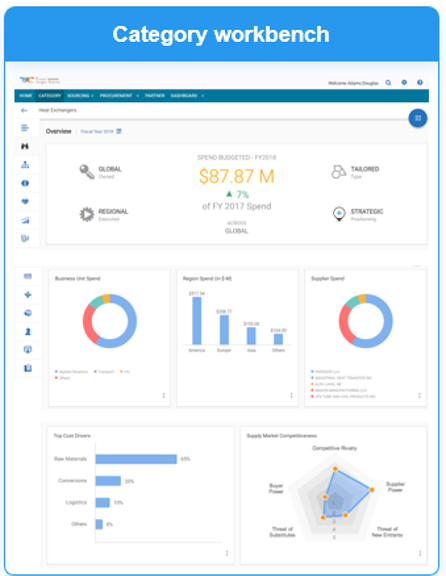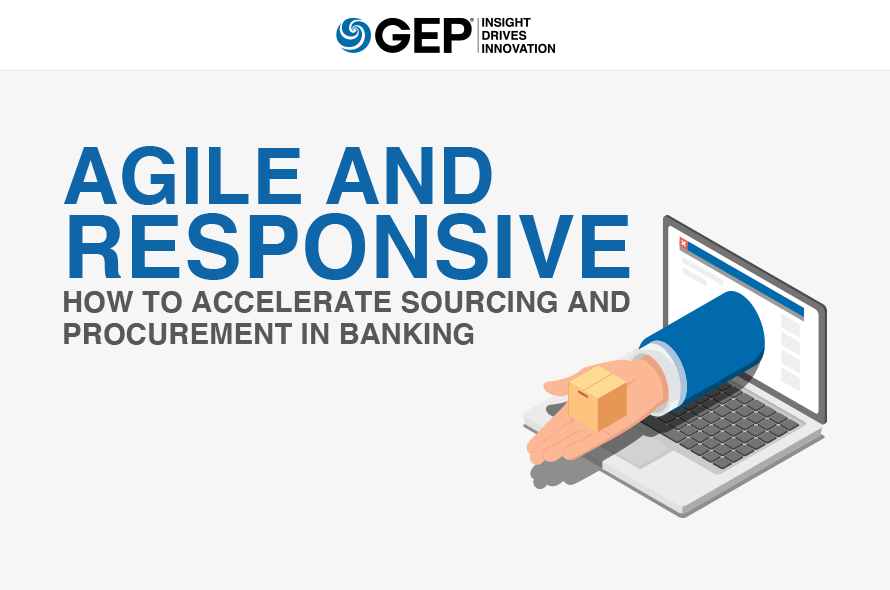The banking industry is adapting to the new normal — new products, digital sales, better customer relationships. To enable these, banks need to invest in new technologies, partner with new suppliers, rapidly.
Procurement can play a key role in supporting these goals — by being more agile, responsive and effective.
In a new bulletin, Agile and Responsive: How to Accelerate Sourcing and Procurement in Banking, GEP’s banking experts discuss how procurement can help banks rapidly identify, negotiate with and onboard new suppliers. They also share strategies to manage new supplier relationships and mitigate risks, while supporting the enterprise goals.
What’s Inside:
- Improving procurement-business collaboration to expedite processes
- Deploying a new approach to onboard suppliers quickly
- Mitigating risks from new suppliers and third-party vendors
It’s a must-read for procurement leaders looking for ways to actively support the growth strategies of their banks.
The banking sector globally is making efforts to understand the “new normal” brought about by the COVID-19 pandemic and how to effectively operate in this changed economic environment.
With the need for social distancing not going away until there is a vaccine against the coronavirus, banks are trying to reshape product offerings, especially in the retail segment. They are leveraging digital distribution channels and their analytics to stem revenue loss and customer attrition and fuel growth.
While they look to drive growth organically by transforming digital sales channels, the M&A route is also likely to be an important lever.
On both the paths, the emphasis will be on operational efficiency — for example, the ability to quickly integrate after a merger and make faster decisions. And in enabling rapid decision-making and execution efficiency, procurement will play a critical role.
The new business landscape and the proliferation of technologies, thanks to fintech companies and niche providers, mean banks have to buy from and partner with vendors of varying sizes, scale and maturity levels.
The ability of a bank’s procurement organization to suitably support its lines of business in building new products and distribution channels by leveraging relevant supplier markets will be directly correlated with:
- Effective supplier market intelligence and benchmarks to quickly identify, negotiate and on-board unchartered “high-potential” suppliers and enable “supplier-led” revenue opportunities
- Mature supplier relationship management program to effectively harness value from a potentially broadened supplier base
- Third-party risk management with adequacy and control, in compliance with regulatory measures and in partnership with the lines of business
Three Typical Bottlenecks in Banking Sourcing and Procurement
Based on our experience working with sourcing and procurement organizations of many global banks with presence across different countries, the following challenges have come to the fore:
1. Unavailability of insightful data and market benchmarks: This includes both internal and external data, such as supplier market intelligence, category price benchmarks, cost models, and sourcing pipeline visibility.
2. Suboptimal third-party risk and vendor management capabilities:Lack of end-to-end processes and tools for gaining visibility and control over management of third-party risk and for maximizing value from the supplier ecosystem.
3. Multiple disconnected technology footprints:This includes several on-premise point solutions and non-intuitive technology platforms to support the source-to-pay processes, travel and contingent labor solutions, and vendor management systems.
A combination of these challenges results in several organizational inefficiencies in sourcing and procurement. This includes a delayed response to servicing time-critical sourcing requests from the lines of business; inability to parallel process third-party risk management and procurement activities to quickly on-board new suppliers, thereby losing out on supporting supplier-led revenue opportunities; and suboptimal reporting and analytics capabilities to enable customized line-of-business and region-specific dashboard for stakeholders at all stages of sourcing and supplier relationship management. The outcome is reduced procurement ROI and, consequently, unworthy tactical partnership between the bank’s sourcing and procurement organization and its lines of business.
What Banks Can Do
1. Customize a sourcing and category workbench that is linked to both internal and external data feeds, giving you a “one-stop” digital portal to drive detailed visibility and actionable insights on your core categories
2. Future-proof supplier relationship management by driving transformational value from consolidated managed services providers while riding the wave of “new and emerging supply base” — the providers of disruptive technology
3. Digitize and integrate third-party risk management solution to your source-to-pay platform so that you can effectively mitigate risk from the newly qualified emerging suppliers and a potentially broadened supply base
An integrated category workbench increases collaboration between the lines of businesses and procurement in proactively managing spend categories and sourcing projects.
It is a “one-stop” view into the category spend profile, cost drivers and models, relevant market indices, benchmarks and supply market dynamics, existing suppliers’ risk-assessed scores, key terms and performance scorecards, the sourcing project pipeline, and negotiation maps for high-value sourcing projects. Once this view is provided with built-in automatic updates, it drives several benefits:

- Advanced analytics, tools and market benchmarks for sourcing managers and procurement business partners related to category supply market, cost drivers and negotiation levers
- Active collaboration between businesses and procurement, with the availability of negotiation maps for high-spend sourcing initiatives and market intelligence for the emerging supply base
- Near real-time visibility into category performance for the lines of business
- Standardized and structured methodology toward design and implementation of category strategy across regions and the lines of business
Future-proofing supplier relationship management means aligning the strategy to the changing needs of the bank’s businesses, like bringing innovative products to market and creating new distribution channels. This implies taking an entirely new approach to expeditiously assess and on-board new suppliers of different profiles with distinctive and transformative capabilities, and proactively broadening the spectrum of strategic collaboration with a consolidated set of outsourced service providers.
As an example of taking a new approach, on-boarding niche providers of transformative technologies will require not only advanced supplier market intelligence capabilities but also creative investment mechanisms to shore up the supplier’s working capital.
Digitizing and integrating third-party risk management solution imply:
- Alignment with risk taxonomy and data standards, and embedding third-party risk management in the source-to-pay process to create an end-to-end interface for all third-party needs and maximize parallel processing
- A single point of entry for stakeholders to capture all third-party risk and procurement requests, enabling reuse and sharing of information with controlled access using the right set of tools
- Third-party risk management effectively addressing the problems of lack of visibility and control on the overall risk management cycle from the perspectives of ownership, coordination and mitigation
- Not limiting third-party risk management to just your direct suppliers but also having the ability to extend risk management to the suppliers’ value chain when there is a need
Procurement organizations in global banks can tremendously benefit from having the right benchmarks, market intelligence and negotiation maps for their core high-spend categories, namely facilities and real estate, financial service and operations, IT, professional services and marketing.
Data-driven and well-rounded category insights increase procurement’s ability to quickly respond to and proactively manage sourcing projects in partnership with the lines of business for new products and services.
Future-proofing supplier relationship management will provide an essential competitive advantage to banks as they are able to effectively identify and engage suppliers across the ecosystem. Supplier relationship management of the future will become the core competence of a bank’s procurement organization.
Finally, digitization of third-party risk management is a key enabler of procurement’s agility as it can parallel process both third-party risk and procurement requests in real-time using the power of cloud computing and user-friendly technology.
RAPID RESPONSE SOLUTIONS FROM GEP
As the coronavirus crisis intensifies, managing your supply chain is going to get even more challenging. It may be worth finding a partner with deep experience in procurement and supply chain management to reinforce your capabilities and help you stay on course.
If you would like to have a conversation about how we can help, please reach out to our supply chain leadership.

John Piatek
Vice President, Consulting
John has over 15 years of strategy consulting experience managing several large-scale engagements with leading global clients.
At GEP, John is responsible for partnering with leading CPG and retail enterprises on strategy, supply chain and management initiatives. John is also the Chair of GEP’s Thought Leadership Council.

